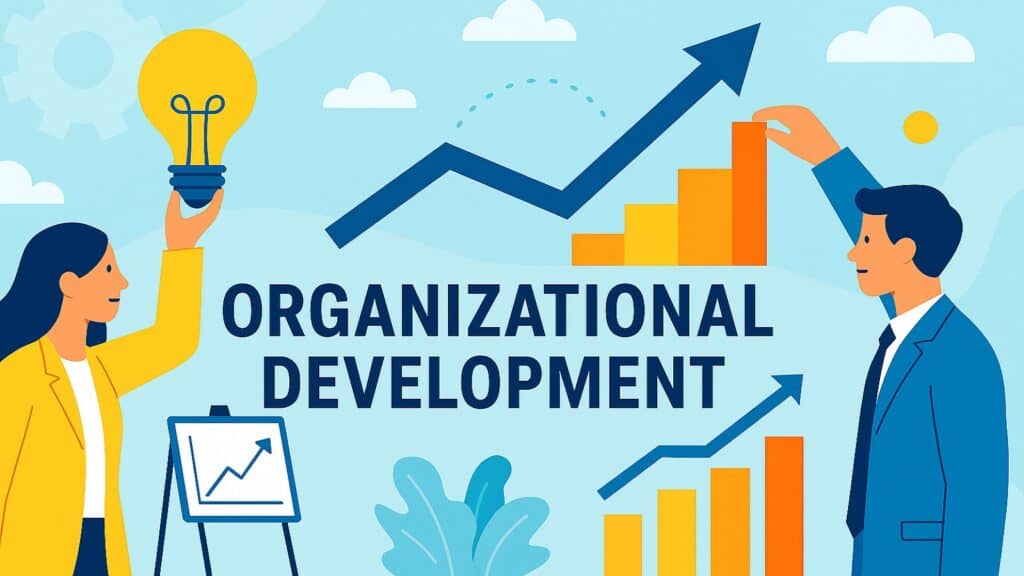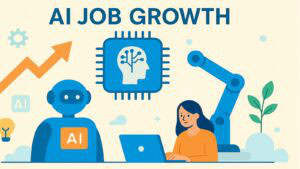Table of Contents
Introduction: The Strategic Rise of Organizational Development (OD)
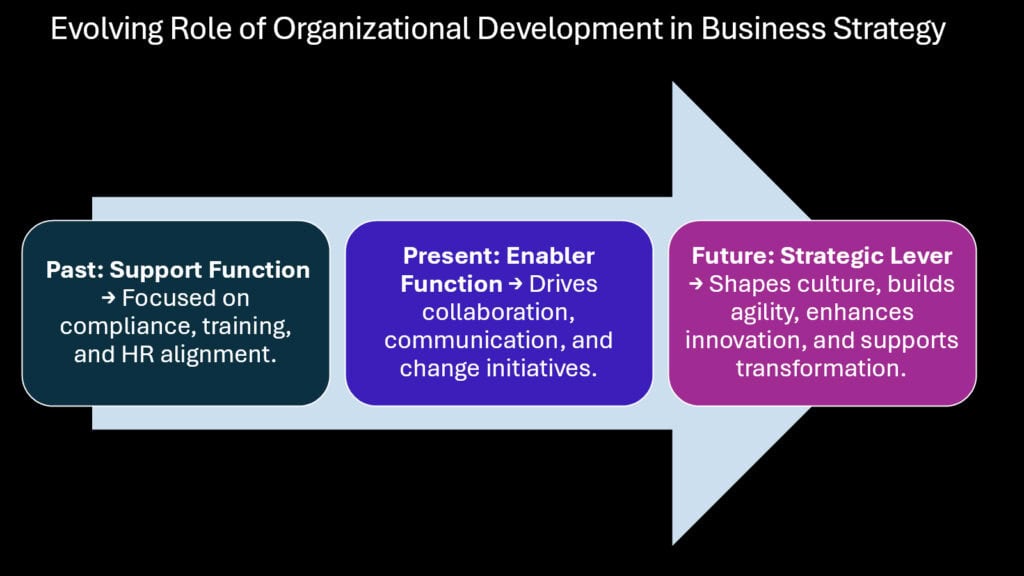
The business landscape has transformed dramatically over the past decades, with companies increasingly recognizing that their greatest competitive advantage lies not in technology or capital alone, but in their ability to develop and harness human potential. Organizational Development (OD) stands as an important Human Resources function that serves as the strategic backbone for this transformation. Far from being a simple training initiative or change management exercise, Organizational Development represents a comprehensive approach to elevating business performance through systematic improvement of organizational effectiveness and human capability.
Modern enterprises face unprecedented challenges that demand agile responses, cultural coherence, and sustained innovation. Traditional hierarchical structures and rigid operational frameworks often prove inadequate in addressing these complexities. Organizational Development emerges as the strategic tool that elevates a business by transforming its culture, enhancing adaptability, and creating long-term value through deliberate interventions in organizational systems, processes, and human dynamics.
The evolution of Organizational Development from academic theory to business imperative reflects a fundamental shift in how leaders perceive organizational success. Companies that invest strategically in Organizational Development initiatives consistently outperform their competitors in metrics ranging from employee engagement to financial performance. This systematic approach to organizational improvement touches every aspect of business operations, creating ripple effects that extend far beyond traditional human resources boundaries.
Table 1: Impact of Organizational Development on HR Functions
| HR Function | Impact of Organizational Development |
|---|---|
| Recruitment | Enhances employer branding and candidate experience through improved organizational culture |
| Training | Aligns learning initiatives with strategic objectives and organizational competency frameworks |
| Leadership | Develops leadership capabilities through systematic succession planning and skill development |
| Employee Relations | Improves communication channels and conflict resolution mechanisms |
| Employee Engagement | Creates participatory environments that increase motivation and commitment |
| Orientation | Streamlines integration processes to accelerate new employee productivity |
| Compensation and Benefits | Aligns reward systems with organizational values and performance metrics |
| Change Management | Builds organizational capacity for adaptation and resilience |
| Onboarding | Enhances cultural integration and role clarity for new team members |
| Offboarding | Maintains positive relationships and knowledge retention during transitions |
This article explores six bold ways Organizational Development elevates business performance, examining how strategic interventions in human systems create sustainable competitive advantages, foster innovation, and drive organizational excellence.
1. Organizational Development Enhances Competitive Advantage
The Resource-Based View framework provides compelling insights into how Organizational Development creates sustainable competitive advantages that transcend traditional market positioning strategies. Unlike tangible assets that competitors can acquire or replicate, the organizational capabilities developed through systematic Organizational Development initiatives represent rare, valuable, and inimitable resources that form the foundation of lasting business success.
Companies that embrace Organizational Development as a strategic imperative develop unique internal capabilities that encompass people, culture, and processes in ways that create distinct market advantages. These capabilities manifest in enhanced decision-making speed, superior customer service delivery, and innovative problem-solving approaches that competitors struggle to duplicate. The interconnected nature of these organizational elements makes them particularly difficult for rivals to reverse-engineer or acquire through external means.
Research from leading business schools consistently demonstrates that organizations with strong Organizational Development programs exhibit superior financial performance compared to their industry peers. These companies develop distinctive competencies in areas such as cross-functional collaboration, knowledge sharing, and adaptive capacity that translate directly into market advantages. The cultural dimensions fostered through Organizational Development create environments where employees contribute beyond basic job requirements, generating innovation and efficiency gains that compound over time.
The strategic implementation of Organizational Development principles enables organizations to build what business theorists term “dynamic capabilities” – the ability to integrate, build, and reconfigure internal and external competencies to address rapidly changing environments. These capabilities become particularly valuable in industries characterized by technological disruption, regulatory changes, or shifting consumer preferences, where traditional competitive advantages quickly erode.
Table 2: Resource-Based View Components Enhanced by Organizational Development
| Resource Category | Enhancement Through Organizational Development |
|---|---|
| Human Capital | Develops specialized skills and knowledge that competitors cannot easily acquire |
| Organizational Culture | Creates shared values and behaviors that drive consistent performance |
| Internal Processes | Establishes efficient workflows and coordination mechanisms |
| Knowledge Systems | Builds repositories of institutional knowledge and learning capabilities |
| Leadership Capabilities | Develops strategic thinking and change management expertise |
| Innovation Capacity | Fosters creativity and continuous improvement mindsets |
The competitive advantages generated through Organizational Development extend beyond immediate operational improvements to encompass strategic positioning benefits that influence market perception, stakeholder relationships, and long-term sustainability.
2. Organizational Development Accelerates Culture-Led Transformation
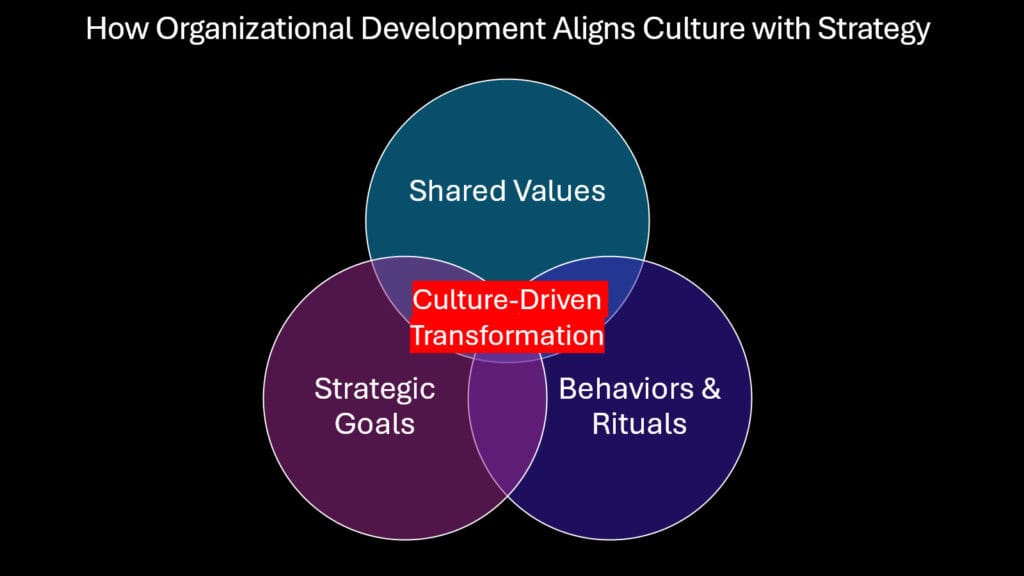
Cultural transformation represents one of the most powerful yet challenging aspects of organizational change, requiring systematic intervention in the beliefs, values, and behavioral patterns that define organizational identity. Organizational Development provides the methodological framework and practical tools necessary to align shared values and behaviors with strategic goals, creating a culture that fuels commitment, creativity, and long-term transformation.
The process of culture-led transformation through Organizational Development involves careful analysis of existing cultural elements, identification of desired future states, and implementation of targeted interventions that bridge the gap between current reality and strategic vision. This approach recognizes that sustainable change must address both visible organizational elements and underlying assumptions that drive employee behavior and decision-making processes.
Successful cultural transformations facilitated by Organizational Development create environments where employees understand their role in achieving organizational objectives and possess the motivation to contribute discretionary effort toward shared goals. These transformations typically involve restructuring communication patterns, redefining performance expectations, and establishing new reward systems that reinforce desired behaviors and outcomes.
The acceleration of cultural change through Organizational Development interventions enables organizations to respond more effectively to market pressures, regulatory requirements, and competitive challenges. Companies that successfully implement culture-led transformations often experience improved employee retention, enhanced customer satisfaction, and increased operational flexibility that supports business growth and adaptation.
Table 3: Cultural Transformation Elements in Organizational Development
| Cultural Element | Transformation Approach |
|---|---|
| Shared Values | Collaborative development of value statements that reflect strategic priorities |
| Communication Patterns | Implementation of transparent, multi-directional communication systems |
| Decision-Making Processes | Establishment of participatory decision-making frameworks |
| Performance Standards | Alignment of individual and team metrics with organizational objectives |
| Learning Orientation | Creation of continuous learning and development opportunities |
| Innovation Climate | Fostering environments that encourage experimentation and risk-taking |
The strategic importance of culture-led transformation extends beyond internal organizational benefits to encompass external stakeholder relationships, brand reputation, and market positioning advantages that support long-term business success.
3. Organizational Development Streamlines Value Creation Paths
Porter’s Value Chain framework illuminates how Organizational Development applications across primary and support activities create systematic improvements in coordination, efficiency, and operational excellence. By applying Organizational Development principles to each activity in the value chain, companies can identify and eliminate friction points while enhancing the interconnections that drive superior customer value and competitive positioning.
The systematic application of Organizational Development to value chain activities involves analyzing how human systems, processes, and organizational structures influence the flow of value creation from input acquisition through customer delivery. This analysis reveals opportunities for improving coordination between departments, reducing handoff inefficiencies, and enhancing the quality of interactions that determine customer experience and satisfaction.
Organizations that implement comprehensive Organizational Development initiatives across their value chains typically experience significant improvements in operational metrics such as cycle time reduction, quality enhancement, and cost optimization. These improvements result from better alignment between organizational elements and strategic objectives, clearer role definitions, and enhanced communication patterns that facilitate smoother workflow execution.
The streamlining of value creation paths through Organizational Development also enables organizations to identify and develop new sources of competitive advantage within existing operations. Companies often discover untapped potential in areas such as supplier relationships, internal process optimization, and customer service delivery that generate measurable business impact when properly developed and managed.
Table 4: Value Chain Activities Enhanced by Organizational Development
| Value Chain Activity | Organizational Development Impact |
|---|---|
| Inbound Logistics | Improved supplier relationship management and inventory coordination |
| Operations | Enhanced process efficiency and quality control systems |
| Outbound Logistics | Streamlined distribution and customer delivery processes |
| Marketing and Sales | Better customer relationship management and market responsiveness |
| Service | Improved customer support and satisfaction delivery |
| Procurement | Strategic supplier partnerships and cost optimization |
| Technology Development | Enhanced innovation processes and knowledge management |
| Human Resource Management | Integrated talent development and performance systems |
| Firm Infrastructure | Aligned planning, finance, and quality management systems |
The comprehensive approach to value chain optimization through OD creates synergistic effects that multiply the impact of individual improvements across the entire organizational system.
4. Organizational Development Fuels Agility and Change Readiness
Contemporary business environments demand unprecedented levels of organizational agility and change readiness, capabilities that traditional hierarchical structures and rigid operational frameworks often impede rather than enable. Organizational Development principles provide the foundation for embedding adaptability into team structures, leadership practices, and strategic planning processes that enable rapid response to market disruptions and competitive challenges.
The development of organizational agility through systematic Organizational Development interventions involves creating flexible structures, enhancing decision-making speed, and building capabilities for continuous adaptation. These efforts typically focus on reducing bureaucratic barriers, empowering front-line decision-making, and establishing feedback mechanisms that enable rapid course correction when circumstances change.
Companies across various industries have demonstrated the practical value of Organizational Development in building change readiness. Technology firms navigate product lifecycle changes more effectively, manufacturing companies adapt to supply chain disruptions with greater resilience, and service organizations respond to customer preference shifts with improved speed and accuracy. These capabilities become particularly valuable during periods of economic uncertainty or industry transformation.
The strategic implementation of change readiness through Organizational Development extends beyond reactive adaptation to encompass proactive capability building that positions organizations to capitalize on emerging opportunities. Companies with strong change readiness often identify market trends earlier, develop innovative solutions faster, and execute strategic pivots more successfully than their less agile competitors.
Table 5: Agility Components Developed Through Organizational Development
| Agility Component | Development Approach |
|---|---|
| Structural Flexibility | Design of adaptable organizational structures and reporting relationships |
| Decision-Making Speed | Implementation of distributed authority and streamlined approval processes |
| Learning Velocity | Creation of rapid learning and knowledge sharing mechanisms |
| Resource Mobility | Development of cross-functional skills and flexible resource allocation |
| Strategic Sensing | Establishment of environmental scanning and trend analysis capabilities |
| Execution Excellence | Building of rapid implementation and course correction capabilities |
The cultivation of organizational agility through OD creates sustained competitive advantages in markets characterized by increasing volatility, uncertainty, complexity, and ambiguity.
5. Organizational Development Strengthens Knowledge and Learning Ecosystems
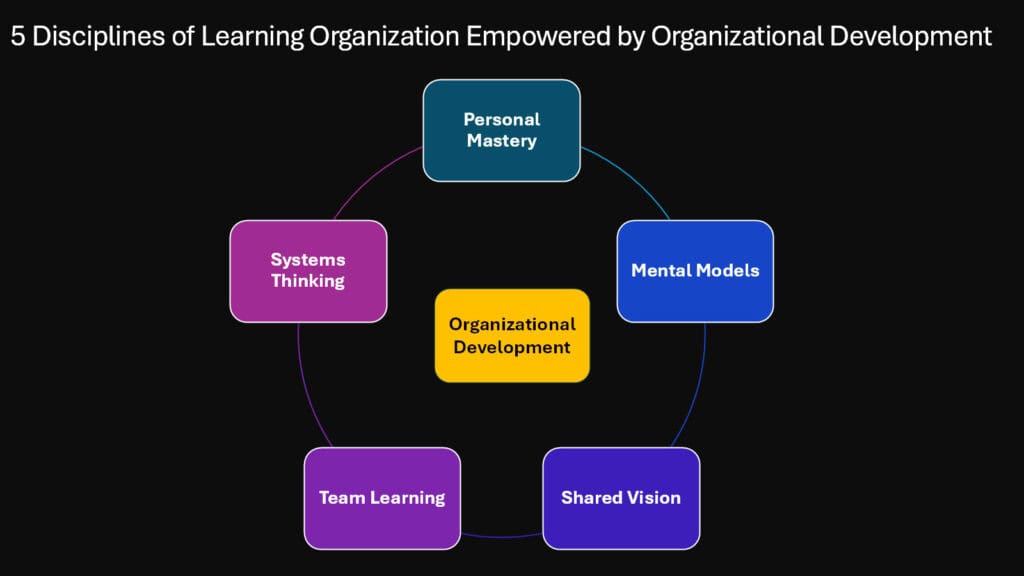
Peter Senge’s Learning Organization framework emphasizes the critical importance of building systems where learning is ongoing, collective, and strategic, ensuring that organizations evolve alongside their environments rather than falling behind competitive or technological developments. Organizational Development provides the methodological foundation for creating these learning ecosystems through systematic intervention in knowledge management, skill development, and organizational memory systems.
The construction of robust learning ecosystems through Organizational Development involves multiple interconnected elements including formal training programs, informal knowledge sharing networks, mentoring relationships, and systematic capture of organizational learning from both successes and failures. These elements work together to create environments where learning becomes embedded in daily operations rather than confined to isolated training events.
Organizations with strong learning ecosystems demonstrate superior performance in adapting to technological changes, regulatory requirements, and market shifts. These companies develop institutional knowledge that transcends individual expertise, creating organizational capabilities that persist despite personnel changes and provide sustainable competitive advantages over time.
The strategic value of learning ecosystems extends beyond operational efficiency to encompass innovation capacity and strategic foresight. Companies that excel in organizational learning often identify emerging trends earlier, develop innovative solutions more effectively, and maintain technological and market leadership positions through continuous capability enhancement.
Table 6: Learning Organization Components Enhanced by Organizational Development
| Learning Component | Enhancement Strategy |
|---|---|
| Systems Thinking | Development of holistic perspective and interdisciplinary collaboration |
| Personal Mastery | Individual skill development and continuous learning commitment |
| Mental Models | Challenging assumptions and expanding cognitive frameworks |
| Shared Vision | Collaborative development of organizational purpose and direction |
| Team Learning | Creation of collective intelligence and collaborative problem-solving |
| Knowledge Management | Systematic capture, storage, and sharing of organizational knowledge |
The development of comprehensive learning ecosystems through OD creates self-reinforcing cycles of improvement that enhance organizational capability and competitive positioning over extended periods.
6. Organizational Development Drives Employee-Centric Innovation
Innovation in contemporary organizations increasingly depends on the active participation, creativity, and commitment of employees at all organizational levels rather than being confined to specialized research and development departments. Organizational Development fosters participation, trust, and inclusion that give employees the confidence and tools to innovate from the ground up, creating sustainable sources of competitive advantage through distributed innovation capabilities.
The cultivation of employee-centric innovation through Organizational Development involves creating psychological safety, establishing clear innovation processes, and providing resources and recognition for creative contributions. These elements work together to unlock the innovative potential that exists throughout the organization while ensuring that innovation efforts align with strategic objectives and customer needs.
Companies that successfully implement employee-centric innovation programs through Organizational Development often experience significant improvements in product development speed, service quality enhancement, and operational efficiency gains. These improvements result from tapping into the collective creativity and problem-solving capabilities of their workforce rather than relying solely on top-down innovation initiatives.
The strategic importance of employee-centric innovation extends beyond immediate operational benefits to encompass long-term competitive positioning and organizational resilience. Companies with strong innovation cultures demonstrate superior ability to adapt to changing market conditions, customer preferences, and technological developments while maintaining operational excellence and customer satisfaction.
Table 7: Employee-Centric Innovation Elements
| Innovation Element | Development Approach |
|---|---|
| Psychological Safety | Creation of environments where employees can express ideas without fear |
| Creative Processes | Establishment of systematic approaches to idea generation and evaluation |
| Resource Allocation | Provision of time, tools, and funding for innovation activities |
| Recognition Systems | Implementation of rewards and acknowledgment for innovative contributions |
| Cross-Functional Collaboration | Facilitation of diverse team composition and knowledge sharing |
| Customer Connection | Direct employee engagement with customer needs and feedback |
The development of comprehensive employee-centric innovation capabilities through Organizational Development creates sustainable competitive advantages that compound over time as organizational innovation capacity continues to expand and mature.
Conclusion: Why Organizational Development Is the Real Growth Engine
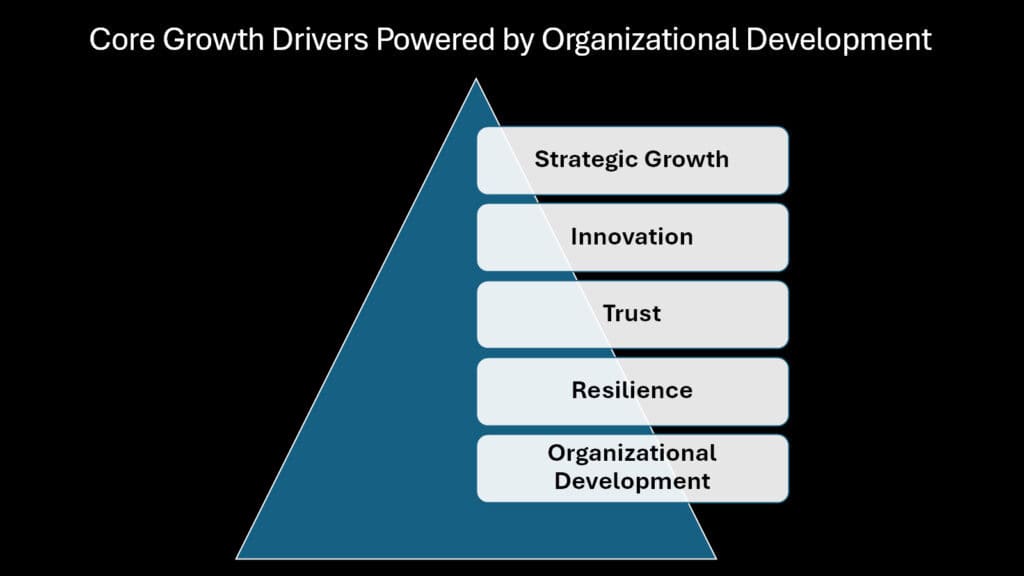
The examination of these six bold ways Organizational Development elevates business performance reveals a fundamental truth about contemporary organizational success: sustainable competitive advantage increasingly depends on the systematic development of human and organizational capabilities rather than traditional factors such as capital, technology, or market position. Organizational Development serves as the real growth engine because it creates the foundation for all other business improvements while building adaptive capacity for future challenges and opportunities.
The interconnected nature of these six approaches demonstrates how Organizational Development creates synergistic effects that multiply the impact of individual interventions across the entire organizational system. Companies that invest strategically in Organizational Development initiatives create self-reinforcing cycles of improvement that enhance performance across multiple dimensions simultaneously while building resilience for long-term sustainability.
The strategic importance of Organizational Development extends beyond internal organizational benefits to encompass external stakeholder relationships, market positioning, and industry leadership that drive sustained business growth. Organizations that excel in Organizational Development often become employers of choice, preferred business partners, and market leaders in their respective industries through the systematic cultivation of excellence in human and organizational systems.
Table 8: Organizational Development Impact on Business Functions
| Business Function | Impact of Organizational Development |
|---|---|
| Marketing | Enhanced customer understanding and brand authenticity through aligned organizational culture |
| Sales | Improved customer relationship management and sales performance through better training and motivation |
| Operations | Increased efficiency and quality through process optimization and employee engagement |
| Finance | Better financial performance through cost reduction and revenue enhancement initiatives |
| Corporate Strategy | Enhanced strategic planning and execution capabilities through improved organizational alignment |
| Information Technology | Improved technology adoption and digital transformation through change management expertise |
| Research and Development | Increased innovation capacity through collaborative culture and knowledge sharing |
| Supply Chain Management | Better supplier relationships and logistics efficiency through enhanced communication |
| Customer Service | Superior customer satisfaction through employee empowerment and service excellence |
| Legal and Compliance | Improved risk management through better organizational communication and accountability |
The future of business success increasingly depends on organizational capabilities that enable rapid adaptation, continuous learning, and sustained innovation in environments characterized by accelerating change and increasing complexity. Organizational Development provides the methodological framework and practical tools necessary to build these capabilities while creating organizational cultures that attract and retain top talent, inspire customer loyalty, and generate sustainable competitive advantages that transcend traditional business boundaries.
The investment in Organizational Development represents a strategic choice to build organizational excellence from the inside out, creating value that extends far beyond immediate operational improvements to encompass long-term growth potential and market leadership. Companies that recognize Organizational Development as their real growth engine position themselves for sustained success in an increasingly competitive and dynamic business environment.

